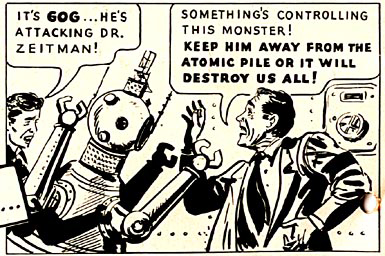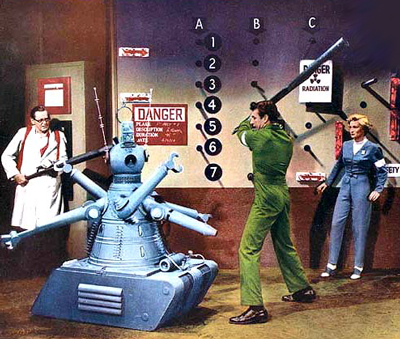
 |
|
|
|
When producer George Pal started the '50s sci-fi craze with his big hit Destination Moon some critics predicted that his semi-docu scientific approach would continue to be the norm. We all know that most of the genre instead went the way of invaders from space and radioactive monsters. Producer Ivan Tors received good marks for three middle '50s titles that seemed to take scientific subjects seriously. The Magnetic Monster (just released and soon to be reviewed here) concerned a brainy pair of investigators desperately trying to neutralize an unstable and very dangerous new element. Riders to the Stars saw a flight of rocket pilots attempting to capture a meteorite in mid-orbit. The third and most elaborate Ivan Tors sci-fi feature is GOG, a futuristic and definitely jingoistic hi-tech espionage thriller that unconsciously reveals the galloping militaristic paranoia of the time. Produced in color and originally released in 3D, GOG featured an element that guaranteed its success as matinee-bait for the kiddie set: robots on the rampage. Office of Scientific Investigation (OSI) agent David Sheppard (Richard Egan, paying his dues on the cusp of stardom) is flown to a secret desert installation to investigate the murders of several scientists. Lab director Dr. Van Ness (Herbert Marshall, repeating from Riders to the Stars) shows Taggart various experiments underway at the underground lab, which is overseen by a vast computer called NOVAC, or The Brain. David also meets up with Joanna Merritt, Van Ness's assistant (Constance Dowling, the producer's future wife). Only slowly does it become clear that Novac and its robot helpers GOG and MAGOG are under the nefarious influence of outside saboteurs. 
GOG was hot stuff for sci-fi fans in 1954. The lab is like something from a James Bond film made ten years later, a completely buried facility ringed by hidden radar antennae and defensive sun-focusing mirror weapons. The lab is organized into color-coded levels, each more secure than the one above, where groups of brilliant scientists are developing new technologies around heat, sound and cold to help future astronauts survive in space. Each scientist has a beautiful female assistant. The whole shebang is controlled by NOVAC, a computer so complicated that its own inventor has difficulty figuring out how it works (!).NOVAC has remote control over almost everything in the entire complex, from all the instruments to door locks. To run the nuclear reactor that powers the lab, the computer controls two automatons designed very much like modern security robots -- an upright shaft ringed with tools on folding arms, all resting on a base that rolls around on treads like a tank. The robots also have names, Gog and Magog. A meek technician (William Schallert, seemingly in 90% of classic Hollywood Sci-Fi fare) is supposed to monitor Gog and Magog. No sooner has Sheppard arrived than more scientists are killed, all seemingly trapped by their own experiments. One is rapidly deep-frozen, and shatters on the floor when he topples over (off screen). A security man is killed by sound waves and a lady assistant is almost murdered by a sun-heat ray. When she thwarts the heat ray by breaking a mirror, she seems the only practical person in the whole complex. This is where GOG disconnects with its own subject matter; it's as if its script had been cooked up by some very savvy science fiction enthusiast, and then finished by someone with no knowledge of science whatsoever. Quite early in the story everybody explains the concept of remote control, but nobody even guesses that NOVAC could itself be controlled from without, not even after a rogue UFO is spotted high in the atmosphere over the lab. David is even shown little remote control receivers that keep showing up in various suspicious places. Only when Gog and Magog go on the fritz and sabotage the reactor does the stuffy Dr. Zeitman (John Wengraf) get wise. Kids back in the day jumped out of their skins when the robots activated on their own, but nowadays viewers are going to be way ahead of the gag. 
GOG makes early use of what would become a Sci-fi must -- sliding electric pocket doors. Otherwise the art direction leans heavily on items newly available in garden stores: wavy green Plexiglas panels and shiny glass bricks. Not exactly what you'd expect to see in a zillion dollar super-secret science establishment. But one viewer must have paid very close attention to the movie: Michael Crichton. The super-laboratory in his influential crossover best seller The Andromeda Strain is very closely modeled on this one. It lies hidden beneath the sands of the desert and it has the same multi-level design, with the same security setup. Instead of a nuclear reactor, Crichton is fitted with a fail-safe security device, an atomic bomb rigged to "cauterize" the site should a dangerous alien organism get out of control. GOG has its scene with a scientist dodging a heat ray in one of the labs, and in Andromeda the hero must pass through an airshaft as a gauntlet of laser weapons fire at him. The big crisis in both movies is a potential nuclear disaster; author Crichton uses an even more commercial finale that involves a deadline-countdown to an unwanted detonation, as in Goldfinger. Unfortunately, in GOG we're wondering why NOVAC needs two robots to monitor the reactor. It is already hard-wired into a remote-control relationship with every doorknob in the building. Why aren't Gog and Magog redundant? This is the film that ends with both the hero and heroine getting a potentially lethal dose from the reactor, as reflected in their safety badges. Our accidentally irradiated lovers are last seen happy and smiling in the lab hospital: "The doctors say we'll be okay, we just got a little too much radiation!" All's well that ends well� at least they'll be able to find each other in the dark. Disturbingly enough, the sabotage spy plane's mission is to stop the Americans from putting that helio-death ray into orbit. The plan is to use the heat ray weapon as a threat against the Enemies of Freedom and thereby insure the peace. The OSI's solution to the Cold War, therefore, is for the United States to militarily dominate the world. The last scene shows the armed space station being sent up in a rocket -- a Nazi V2, ironically. GOG remains an ideological souvenir from a time when the H-Bomb lifted international tensions to a new level. The prescription is always the same: more secrecy, better bombs and space research to dominate the globe with 'peacekeeping' weapons. The happy ending of GOG reinforces the climate of Cold War terror. 
We're told from some sources that GOG didn't see very many play dates in 3D, as it was finished just as the novelty of 3-dimensional movies faded. At a big 3D festival at the Egyptian Theater in Hollywood in 2003, we were shown GOG in full Polaroid 3D, a screening that was attended by director Strock, actor William Schallert and hosted by director Joe Dante. Savant's whole report is here (scroll down to September 14, 2003) but I'll excerpt the relevant section: The Egyptian Theater was packed, and with glasses firmly in place, GOG began. It ran at 1:37, even though it was clearly formatted for 1:66 (judging by the titles). The 3-D effect was fine, with many shots organized to place objects in different planes of depth. The apparent depth-space between 'planes' seems to be exaggerated in many shots, because there were many scenes where people closer to the camera looked too small in comparison to people behind them. The effect is a variation on the telephoto shot in baseball games past the pitcher's mound toward home plate, where the batter looks bigger than the pitcher, who's 30 yards closer. A speaker told us that UA has no 3D versions of GOG, and that it was thought to be lost until someone (presumably a collector) found a left eye to match a right eye print. Unfortunately, the left eye was badly faded. This didn't hurt the 3-D, but the resulting colors were subdued. If one closed a left eye, the colors popped into bright, true hues. Close the right eye, and the picture turned purplish. Together, they combined into a satisfactory but slightly faded composite. Very interesting. After the show, director Joe Dante introduced the charming William Schallert, who read from his 1953 datebook all the roles he took in plays and bits in movies that year. He said that all he really remembered about GOG was that he earned about $250 and got strangled by the robot. Director Herbert L. Strock talked about making this film and others, and told us that like Andre De Toth and Raoul Walsh, he had monocular vision and couldn't fully appreciate his own 3-D picture! UA premiered the movie in 3D at the Paramount Theater on Hollywood Blvd. (now the El Capitan) but then released it only flat, which made Strock angry -- they'd gone to such trouble and expense to do it in 3D. Everyone present agreed that this was the first time in 49 years that GOG had been publicly screened in real 3D. The MGM Limited Edition Collection's DVD-R of GOG is a satisfactory but not ideal presentation. Unlike Warners, the MGM series does not make original theatrical aspect ratios a priority, so GOG is presented flat full-frame. The text blocks in the main titles are clearly arranged for a wider format, probably 1:66. Practically every other studio has adopted an original OAR policy. At present, MGM does not normally do special transfers for MOD releases. Widescreen B&W movies are especially out of luck. So what happens is that we see too many pictures with empty spaces above and below the relevant action. If the cameraman had any special composition in mind, it has been lost. This same complaint dogs a very arty Jack Garfein UA picture I'll be reviewing very soon, the 1961 version of Something Wild. That said, this is a good-looking disc. Color and sharpness are basically fine, and the show displays little damage or other problems. The audio is very good as well. No extras are included. The packaging lists Orion as a rights holder, when the film has always been a straight United Artists item. The cover art is perhaps the laziest I've seen from the Limited Edition Collection: it's lucky for MGM that some of their titles are so desirable. Being a confirmed Sci-Fi addict, I'd go for this title anyway. It's never seen a Home Video release in any format and my old VHS from TV is pretty pathetic.
On a scale of Excellent, Good, Fair, and Poor,
GOG rates:
Reviews on the Savant main site have additional credits information and are often updated and annotated with reader input and graphics. Also, don't forget the 2010 Savant Wish List. T'was Ever Thus.
Review Staff | About DVD Talk | Newsletter Subscribe | Join DVD Talk Forum |
| ||||||||||||||||||